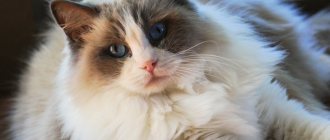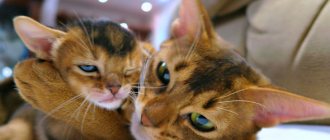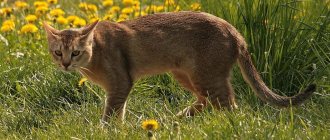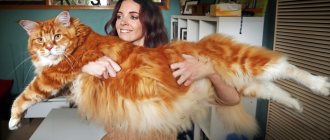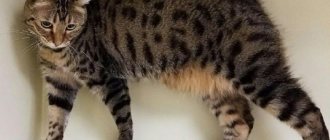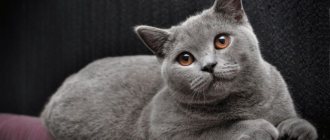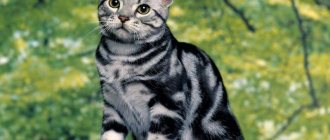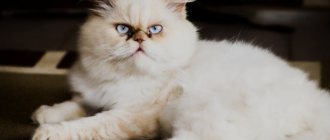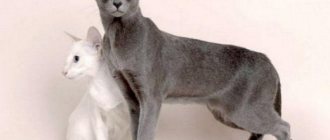Cats are primarily carnivorous animals. Nature created them this way. And despite the fact that these animals live side by side with humans for many centuries, there is an aggressive trait in each of them. Finding itself in a hopeless situation or angry, any cat can turn into a wild beast.
Photo: Pixabay.com
However, some cat breeds are more willful than others. She is much less tolerant not only of humans, but also of other animals. Therefore, they can show aggression without obvious reasons. These breeds differ in a number of features:
- A pronounced territorial instinct, which consists of distrust or attacking strangers or cats who find themselves in the cat’s territory.
- Expressed love for only one person (the owner) and indifference to everyone else.
- They tend to defend themselves by biting.
- Hybrid and exotic breeds that are closely related to wild cats.
It should be noted that these character traits do not prevent these cats from being affectionate and kind pets if they are properly raised and the people nearby respect their interests and do not violate their personal space.
We present to your attention a selection of the most aggressive cat breeds. The rating contains 12 breeds that show aggression most often.
Rating:
- Siamese
- Siberian
- Maine Coon
- Balinese
- Savannah
- Pallas' cat
- Mekong Bobtail
- Ocicat
- Turkish Angora
- Abyssinian
- Persian
- Ukrainian Levkoy
Cathesian
Not the most common, but one that ranks among the top evil cat breeds is the Chartreuse or Cathesian. Cats of French origin are extremely jealous, considering themselves the only ones they love. They cannot stand competition, they do not want strangers and are afraid of them, and for this reason they do not get along with other pets at all. Their capricious nature also requires space for maintenance; a private house is perfect.
Self-sufficiency, impatience with changes in daily routine and habitat, and reluctance to forced hugs make Chartreux not the most desirable family members. But if they really love the owner, they will show him their affection in every possible way and seek attention.
Siamese cat
Siamese cats are considered one of the most beautiful in the world. This breed is very popular not only because of its beautiful appearance, but also because of its high intelligence.
These cats are very smart and easy to train. They are easy to train and even loyal to humans. But in addition to high intelligence, these cats also received phenomenal memory.
Once an owner offends a Siamese cat at least once, he will remember it forever . And not only will he remember, but he will also want to take revenge at the moment when the enemy is unarmed.
There are many examples of Siamese cats attacking their owners while the latter were sleeping in bed. Therefore, you should not offend Siamese cats or treat them unfairly.
Mekong Bobtail
The viciousness of these cats does not apply to everyone. They are incredibly loyal to their owner and behave affectionately and friendly with him. The animal is capable of showing aggression towards strangers. It intuitively senses danger or malice and tries with all its might to prevent this from happening in the house where it lives. The cat prefers to use its teeth to fight the enemy.
Mekong Bobtails resemble dogs in their guarding qualities. What makes them similar is their love for walking on a leash and good ability to learn commands.
Mekong Bobtails are patient and friendly with children and willing to play. The animal does not tolerate long absences from its owner, although it calmly remains at home alone during the day.
An interesting feature of the Mekong Bobtail is matriarchy. If there is a couple of this breed, then the cat usually takes care of the kittens, and the cat takes the dominant position. Even with its smaller size, it is capable of chasing and offending the male.
Detailed description of the Mekong Bobtail breed »
Oriental
Oriental cats are next on the list of the most evil breeds. They are very capricious, selfish, deciding everything and always for the whole world. They are fast and energetic, they do not like being forced to be affectionate or being ignored. If you don't notice their ears, you risk getting a depressed cat in the house who will behave vindictively and disrespectfully, marking in slippers and making marks on wallpaper and furniture.
Snow Shu
A breed called Snow Shoe is not very widespread. This is due to their restlessness, which makes them want to hunt for something or someone, play pranks, and having received punishment, hide and take revenge on a harmful person. Cats - “snowflakes” are smart, can open locks and doors, manage, scatter and hide small change.
Owners say that when Snow Shu raises his voice, he can hit a loud person with his paw. So, think three times before getting such a pet.
Bengal cat
It is no secret that Bengal cats were bred by crossing domestic cats and wild ones. Therefore, in the character of this breed, the temperament of a gentle domestic cat and the burrows of a real wild, unbridled predator are intricately crossed with each other.
In normal circumstances, Bengals are quite calm and serene animals, whose behavior is no different from other domestic cats. However, if it seems to them that there is danger somewhere nearby, the hunting instinct takes over. Therefore, Bengal cats can seriously harm humans .
It is also worth noting that this breed is practically not trainable .
Chausie
Aggressive jungle cats took part in the selection of this breed. Representatives of the reeds have never been distinguished by a calm character, and they passed this heritage on to their descendants Chausi.
“Wild” blood makes itself felt in the character of any cat of this breed . But the aggressive nature of these cats can be curbed with proper, strict education. You need to give your kitten enough attention from an early age, and then he will grow into a well-mannered pet.
But if the owner does not have time to communicate with his pet, then baby Chausie will grow into a naughty cat who is capable of doing completely unthinkable things. The owner can expect not only scratched hands, but also a house turned upside down.
Maine Coon
Representatives of this breed delight people with their stern appearance and massive body. In size, they are almost twice the size of ordinary cats.
They are distinguished not only by their beautiful and unusual appearance, but also by their flexible mind and high intelligence.
Maine Coons by their nature are real phlegmatic people. They are quite calm and confident. However, if you raise a Maine Coon incorrectly, you can end up with frequent hissing and attempts by the cat to bite or scratch not only strangers, but also its own owner .
However, you should not think that aggressive individuals are common among Maine Coons. Rather, the aggression of this breed is the result of improper upbringing or lack of proper attention of the owner to the cat person.
Signs about a white cat at home
In history, white cats are considered a sign of purity, light and goodness. Such cats protect against any negative magical effects. This property is suitable for those people who work with many people or are forced to constantly adopt the energy of strangers. Typically, this is relevant for doctors, lawyers or businessmen. In the evening, petting the white animal well will help you calm down and lift your spirits. It is advisable to have such cats for those who engage in heavy physical activity.
Turkish van
The Turkish Van cat itself is not evil if it is not pushed to its limits. Representatives of this breed are willful and independent, and therefore may react negatively to certain things.
The Turkish Van is not inclined to aggression, but is capable of hitting back at a small child who has violated his borders. Because of this feature, it is not recommended to leave the animal unattended with children.
The Turkish Van is friendly towards his owners and becomes very attached to one person. The cat strives to take part in all his affairs, to follow on his heels. These traits are reminiscent of dogs. The Turkish van is usually on good terms with the latter.
Females show greater independence. Turkish Van cats strive to dominate. This can manifest itself in relation not only to a cat of the same breed, but also to a dog.
Turkish Vans are active and love to involve their owners in outdoor games. The animal is active and curious, loves to jump, and is not at all afraid of water. Due to the lack of undercoat, the fur of such cats dries quickly, which allows them to successfully swim and fish.
A Turkish Van can be trained to wear a harness and be walked like that. Good health allows partial aviary keeping.
Detailed description of the Turkish Van breed »
jungle cat
Jungle cats are still considered wild , despite the fact that more and more people are expressing a desire to have a representative of this breed at home.
People are most often captivated by the resemblance of this unusual cat to a lynx. The charming tufts on the ears and the massive size of the jungle cat certainly look beautiful.
But nevertheless the natural predatory habits of the breed make themselves felt, and experts generally advise against keeping a jungle cat at home because of its evil and unpredictable nature.
Attention! People who have small children living in the house should especially beware of purchasing this breed. It is no easier to tame a jungle cat than it is to tame a lynx or a cheetah.
British Shorthair
Short-haired graceful cats, which have become a real treasure of Great Britain, have always captivated people from all over the world with their unusual muzzle shape and incredibly beautiful coat.
By nature they are quite independent and calm. The British breed is one of the most popular in the world.
But the British are not at all good-natured . Most often, these cats are not attached even to their own owner and in every possible way show how important personal space is for them.
If he does not want a person to pick him up or stroke him, the cat will demonstrate his reluctance by scratching and biting him.
Savannah
The luxurious spotted color and rather impressive size of the savannah bring to mind associations more with a reduced sevral than with an ordinary domestic cat.
This cat breed is distinguished by fairly high intelligence. They are smart, always loyal to their owner and easy to train.
The owner can raise an excellent friend and companion from a cat of this breed, but other people around will forever remain strangers to her . Therefore, she will want to attack guests at home or passers-by on a walk if she feels that they pose a danger to the savannah itself or to the owner.
How to deal with an angry pet
There are a number of standard recommendations that will help cope with aggression in your pet.
- Raising a cat should be done from early childhood - then it will be easier for the owner to understand the reasons for this behavior and calm the angry pet.
- Showing aggression is not a reason to panic - give the cat the opportunity to hide in a place comfortable for him so that he calms down.
- If attacks of aggression recur regularly, you need to take your pet to the veterinarian to rule out rabies.
- At the first signs of angry excitement (hissing, raising the ridge on the back), you can try to distract the cat with noise, for example, playing loud music.
- It is better not to look into the eyes of an excited pet - he may perceive such behavior as a signal to attack.
Owners of all cats are divided into two groups. The former arrogantly believe that the pet will withstand all the whims of the owner and will perceive him as the leader of the family pack. And the latter know exactly the limits of cat tolerance and never cross them.
In this case, a harmonious and peaceful community of man and cat is formed, in which there is a place for common games and the opportunity to take a break from each other.
Manul
Manul is one of those breeds that cannot be tamed . These cats are too freedom-loving and will never obey a person.
It is worth noting that the disobedience of the Pallas cat is primarily due to the fact that he is not a domestic cat, but a wild one. That is, these cats feel very comfortable living in natural conditions, but they are not adapted to living side by side with humans .
As soon as the manul senses danger, he will immediately attack the person. Its claws are considered very powerful by feline standards, and its fangs are 3 times longer than those of an ordinary cat. It is worth noting that Pallas cats not only behave aggressively, but also look quite menacing .
Why get a white cat?
All white cats, kittens and cats have an aristocratic character. Even their behavior sets the snow-white breed apart from other cats. Tactile communication with white fur will bring bright positive emotions to the owner. Psychologists equate this pastime to meditation. Scientists claim that such a procedure, in 10-15 minutes, will help a person calm down, restore breathing and pulse. This is especially important for people with high blood pressure or nervous excitability. Many psychologists advise petting a white cat for a while before making an important decision. This will help you calm down and concentrate.
Why get a white cat:
- A real antidepressant that does not affect the gastrointestinal tract and does not harm the body;
- The cat will protect you from not very good people, negative emotions, evil eyes, curses and bad moods;
- A cat can be compared to a family doctor. It literally scans a person’s mood and physical indicators. The cat himself can detect the disease and, to the best of his ability, rid the owner of it;
- It can be called a talisman that will attract success, good luck and improve your financial condition. Helps attract good people of the opposite sex into your life;
- The cat itself can drive away loneliness. For singles, a cat will be an alternative in the fight against single existence. He will not obsessively demand attention, but will be able to study and understand the state of mind of the owner.
As you can see, white cats are of great importance for the physical and spiritual balance of the human soul. Cats need love, care and affection. Having received them, the cat will give a lot to its owner.
Features of aggression
An inexperienced cat owner also needs to realize that his pet will not get angry for no reason, simply because he is harmful. Cats tend to become aggressive in certain circumstances that may pose immediate danger to them or appeal to their dormant hunting instincts.
Types of cat aggression
The types of aggression in cats do not imply any clear classification; rather, it is a set of typical everyday situations in which the animal’s behavior changes in a negative direction for the owner. Such situations include:
- intraspecific aggression;
- redirected aggression;
- aggression during affection;
- aggression during play;
- aggression based on fear;
- aggression caused by pain.
Cat aggression always has certain prerequisites
We will talk about each of these types in subsequent chapters.
Intraspecific aggression
This type of aggression involves competition between two cats driven by a specific goal. This aggression can be expressed either directly in a fight or indirectly (when direct contact is impossible). It also happens that a domestic cat “settles scores” with a yard cat, looking intently at him from the window. It doesn’t come to a fight, but the tension that accumulates in your pet from such “exercises” certainly makes itself felt.
Intraspecific aggression occurs in both males and females
The main causes of intraspecific aggression are:
- the appearance of a new cat in an apartment or house;
- meeting a cat that your pet has not seen for a long time and has forgotten;
- competition for any resource: food, territory, females.
Redirected aggression
It is this type of aggression that most inexperienced owners fail to understand. It would seem that there were no reasons for conflict, but suddenly the pet grabbed your arm or leg and did not let go. The reason for such aggression is frustration, which could arise from the same inability to meet the yard cat that we wrote about above and truly “sort things out.” As a result of this impossibility, the cat has to suppress himself and redirect his energy in another direction, to “win back.”
The reasons for redirected aggression often remain unclear to the owner
Aggression during petting
Many owners are very familiar with the situation when a couple of seconds ago a pet purring and basking on their lap begins to bite and scratch the hands that were caressing it. The reason for such “cunning” is not the malice of the animal, but its limited need for physical contact. From an overabundance of touches, a cat can easily become overexcited and not control its impulses, although it does not wish harm to anyone. Therefore, it is important to listen to your animal's needs and not go beyond his comfort zone.
Aggression can overtake a cat at the most unexpected moment for a person.
The main causes of aggression during lacquering are:
- the presence of sore spots in the cat that the owner accidentally came into contact with. If you find a constant negative reaction from the animal when you touch its stomach, then it makes sense to take the cat to the veterinarian;
- owner's intemperance. Some owners can be affectionate with their pet for hours, and although it brings them pleasure, the cat may find such a pastime tiresome and even unbearable. It is necessary to understand that not only people, but also animals have personal boundaries;
- congenital hypersensitivity. Some cats are simply not created for tactile contact and cannot become a fluffy ball for the owner that can be petted for hours. All that remains to be done in such a situation is to come to terms with this peculiarity of the pet.
Not all cats respond positively to tactile contact.
Aggression during play
This type of aggression is quite harmless and is expressed in various ways:
- the cat runs up to you from behind and hits you on the leg with its paw, after which it quickly runs away;
- the cat tries to jump to the person’s hands;
- the cat rushes back and forth without a specific goal;
- the cat disappears from sight, after which it suddenly jumps out at you from its hiding place.
Playful and hunting types of behavior easily transform into each other
Surely, the owner of every cat has encountered at least one of the above phenomena. From the outside, this behavior seems senseless, but in fact it is a manifestation of the pet’s hunting instincts in a playful way. Sometimes it happens that the cat forgets itself and goes on to a real attack, which you need to learn to recognize and stop in time.
Aggression based on fear
Cats that develop this type of aggression are considered to be naturally evil, ungrateful animals, incapable of receiving warmth and care from their owner. But, as we have already said, your pet cannot just be evil; he needs certain motives. The reaction to threat is developed in cats from a very early age and largely depends on the relationship with the mother.
Fears experienced by a kitten in early childhood become the cause of inadequate responses in the future.
If a kitten felt safe in the first months of its life, then most likely it will have fewer reasons to experience aggression when in contact with humans or other animals. That kitten, which for a number of reasons had to become independent too early, often becomes distrustful and closed, not inclined to make contact. For example, distrust is characteristic of stray cats.
The cat's mistrust of people causes his frequent aggressive outbursts
Subsequently, such distrust of the world around us manifests itself in various ways:
- cat aggression directed at the veterinarian;
- attempts to “eliminate” guests and other strangers from the house;
- the difficult process of getting used to a new pet or small child in the house.
Aggression caused by pain
As we already said in the chapter on aggression during petting, cats can react sharply to touching certain parts of the body when a certain pathology occurs. Since animals do not have the ability to verbally describe their symptoms to their owner, they have to communicate their poor health through aggression.
Sometimes the reason for refusing affection is an undiagnosed pathology
Such aggression is also often confused with causeless aggression, which sometimes leads to worsening symptoms. Therefore, if you notice that your cat has suddenly “deteriorated in character,” watch him and see if he has other painful symptoms in the form of decreased appetite, weakness, temperature and other general signs indicating illness.
Aggression caused by mental instability
In very rare cases, cat aggression has no objective reasons and is associated with disorders of the animal’s central nervous system. A veterinarian should examine such pets, since even the most skilled owner will not be able to cope with an unbalanced cat on his own. Before going to a specialist, it is important to take a short medical history, which will allow the doctor to form a holistic impression of the animal. Supporting points that will make writing an anamnesis easier are given below.
History taking

